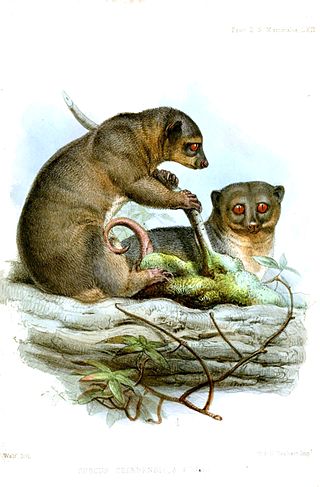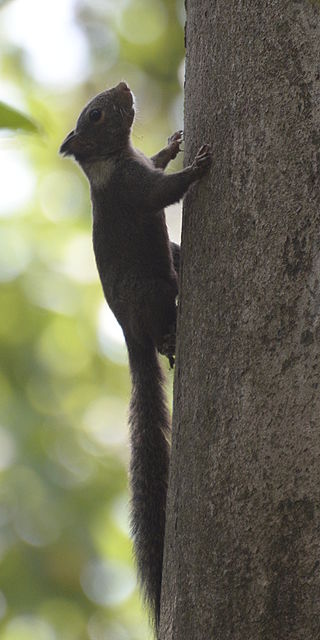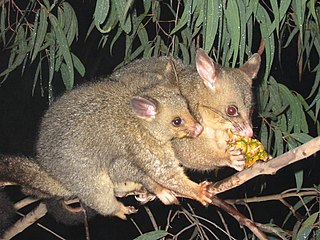
Sulawesi, also known as Celebes, is an island in Indonesia. One of the four Greater Sunda Islands, and the world's 11th-largest island, it is situated east of Borneo, west of the Maluku Islands, and south of Mindanao and the Sulu Archipelago. Within Indonesia, only Sumatra, Borneo, and Papua are larger in territory, and only Java and Sumatra have larger populations.

Phalangeriformes is a paraphyletic suborder of about 70 species of small to medium-sized arboreal marsupials native to Australia, New Guinea, and Sulawesi. The species are commonly known as possums, gliders, and cuscus. The common name "possum" for various Phalangeriformes species derives from the creatures' resemblance to the opossums of the Americas. However, although opossums are also marsupials, Australasian possums are more closely related to other Australasian marsupials such as kangaroos.

Wallacea is a biogeographical designation for a group of mainly Indonesian islands separated by deep-water straits from the Asian and Australian continental shelves. Wallacea includes Sulawesi, the largest island in the group, as well as Lombok, Sumbawa, Flores, Sumba, Timor, Halmahera, Buru, Seram, and many smaller islands. The islands of Wallacea lie between the Sunda Shelf to the west, and the Sahul Shelf including Australia and New Guinea to the south and east. The total land area of Wallacea is 347,000 km2 (134,000 sq mi).

Lore Lindu National Park is a protected area of forest on the Indonesian island of Sulawesi, in the province of Central Sulawesi. The Indonesian national park is 2,180 km2 covering both lowland and montane forests. It provides habitat to numerous rare species, including 77 bird species endemic to Sulawesi. The national park is designated as part of the UNESCO World Network of Biosphere Reserves. In addition to its rich wildlife, the park also contains megaliths dating from before 1300 AD.

Phalanger is a genus of possums. Its members are found on New Guinea, the Maluku Islands, other nearby small islands, and Australia's Cape York Peninsula. They are marsupials of the family Phalangeridae, and are one of the four genera whose species are commonly referred to as cuscuses.

The Sulawesi bear cuscus, also known as the Sulawesi bear phalanger, is a species of arboreal marsupial in the family Phalangeridae that is endemic to Sulawesi and nearby islands in Indonesia. It lives in tropical moist lowland forest at elevations up to 600 m (2,000 ft) and is diurnal, folivorous and often found in pairs. A. ursinus is threatened by hunting, collection for the pet trade and deforestation.

The bear cuscuses are the members of the genus Ailurops. They are marsupials of the family Phalangeridae.

The Woodlark cuscus is a species of marsupial in the family Phalangeridae endemic to Papua New Guinea, specifically on Madau and Woodlark Island, a part of the Milne Bay Province of Papua New Guinea. It happens to be the largest mammal living on Woodlark Island but it is also found on the neighboring island of Alcester, 70 kilometers south of Woodlark Island.

Spilocuscus is a genus of marsupial in the family Phalangeridae. Its members are found on the Cape York Peninsula of Australia, New Guinea, and smaller nearby islands. It contains the following species:

The Waigeou cuscus or Waigeou spotted cuscus is a species of marsupial in the family Phalangeridae. It is endemic to the island of Waigeo in Indonesia, and consequently the spelling Waigeo cuscus is often used instead of Waigeou cuscus. Unlike all other members of the genus Spilocuscus, both genders are whitish with black spots. It remains fairly common, but its small range makes it vulnerable to habitat loss and hunting.

The black-spotted cuscus is a species of marsupial in the family Phalangeridae. It is among the largest members of the family, only being surpassed by the bear cuscus. It is a relatively colourful species found in forests of northern New Guinea. It is threatened by hunting and habitat loss, and has already disappeared from large parts of its range. Consequently, it is rated as Critically Endangered by IUCN.

The Sulawesi dwarf cuscus is a species of arboreal marsupial in the family Phalangeridae that is endemic to Sulawesi and nearby islands in Indonesia. It inhabits tropical moist lowland forest and is nocturnal, folivorous and usually found in pairs. S. celebensis is threatened by hunting and deforestation.

The Banggai cuscus is a species of cuscus, a type of possum. It is found in the Peleng and Sula Islands to the east of Sulawesi in Indonesia.

Prosciurillus is a genus of rodent in the family Sciuridae, endemic to Sulawesi and nearby small islands, Indonesia. It contains the following species:

The Phalangeridae are a family of mostly nocturnal marsupials native to Australia, New Guinea, and Eastern Indonesia, including the cuscuses, brushtail possums, and their close relatives. Considered a type of possum, most species are arboreal, and they inhabit a wide range of forest habitats from alpine woodland to eucalypt forest and tropical jungle. Many species have been introduced to various non-native habitats by humans for thousands of years.

Tangkoko Batuangus Nature Reserve, Indonesian: Tangkoko-Batuangus Dua Saudara is a nature reserve in the northern part of Sulawesi island of Indonesia, 70 kilometres from Manado City. The reserve covers an area of 8,718 hectares, and includes three mountains: Mount Tangkoko at 1,109 metres, Mount Dua Saudara at 1,361 metres, and Mount Batuangus at 450 metres.
S. celebensis may refer to:

The Sulawesi lowland rain forests is a tropical moist forest ecoregion in Indonesia. The ecoregion includes the lowlands of Sulawesi and neighboring islands.















